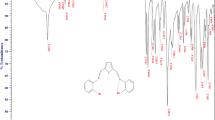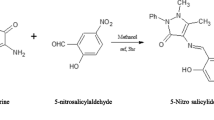Abstract
A series of transition metal complexes of Co(II), Ni(II), Zn(II), Fe(III) and VO(IV) have been synthesized involving the Schiff base, 2,3-dimethyl-1-phenyl-4-(2-hydroxy-3-methoxy benzylideneamino)-pyrazol-5-one(L), obtained by condensation of 4-aminoantipyrine with 3-methoxy salicylaldehyde. Structural features were obtained from their FT-IR, UV–vis, NMR, ESI Mass, elemental analysis, magnetic moments, molar conductivity and thermal analysis studies. The Schiff base acts as a monovalent bidentate ligand, coordinating through the azomethine nitrogen and phenolic oxygen atom. Based on elemental and spectral studies six coordinated geometry is assigned to Co(II), Ni(II), Fe(III) and VO(IV) complexes and four coordinated geometry is assigned to Zn(II) complex. The interaction of metal complexes with Calf thymus DNA were carried out by UV–VIS titrations, fluorescence spectroscopy and viscosity measurements. The binding constants (Kb) of the complexes were determined as 5 × 105 M−1 for Co(II) complex, 1.33 × 104 M−1 for Ni(II) complex, 3.33 × 105 M−1 for Zn(II) complex, 1.25 × 105 M−1 for Fe(III) complex and 8 × 105 M−1 for VO(IV) complex. Quenching studies of the complexes indicate that these complexes strongly bind to DNA. Viscosity measurements indicate the binding mode of complexes with CT DNA by intercalation through groove. The ligand and it’s metal complexes were screened for their antimicrobial activity against bacteria. The results showed the metal complexes to be biologically active, while the ligand to be inactive.












Similar content being viewed by others
References
Donia AM, EI-Saled FA (1988) Complexes of manganese(II), cobalt(II) and nickel(II) with the keto form of some antipyrine Schiff base derivatives. Polyhedron 7:2149–2153
Joseph M, Nair KM, Radhakrishnan PK (1995) Complexes of yttrium and lanthanide bromides with 4-N-(2′-hydroxybenzylidene) aminoantipyrine. Synth React Inorg Met-Org Chem 25(8):1331–1343
Maurya RC, Mishra DD, Trivedi PK, Mukherjee S, Shrivastava PK (1992) Synthesis and characterization of some hovel pehta-coordihated mixed-ligakd derivatives of zinc(II)-bis(acetylacetone) and-bis(acetoacetanilide) chelates with 2/3-pyrazoline-5-one derivatives. Synth React Inorg Met-Org Chem 22(4):403–414
Agarwal RK, Singh G (1986) Preparation, spectral and thermal studies of some oxovanadium(IV) complexes of 4-aminoantipyrine. Synth React Inorg Met-Org Chem 16(8):1183–1196
Chopra JR, Uppal D, Arrora US, Gupta SK (2000) Synthesis and spectral studies of Cu(II) complexes of 4[N-(2-hydroxy-1-naphthalidene) amino]antipyrine thiosemicarbazones. Asian J Chem 12:1277–1281
Radhakrishnan PK, Indrasenan P, Nair CGR (1984) Complexes of lanthanide nitrates with 4n-(2′-hydroxy benzylidene)-aminoantipyrine. Polyhedron 3:67–70
Radhakrishnan PK (1986) complexes of lanthanide perchlorates with 4-N-(2′-hydroxy-1′-naphthylidene)aminoantipyrine. Polyhedron 5:995–998
Maurya RC, Mishra DD, Pandey M, Shukla P, Rathour R (1993) Synthesis and spectral studies of octacoordinated dioxouranium(VI) complexes with some schiff bases derived from 4-acetyl-2,3-dimethyl-l-(4-methylphenyl)-3-pyrazoline-5-one and aromatic amines. Synth React Inorg Met-Org Chem 23(1):161–174
Ismail KZ, EI-Dissouky A, Shehada AZ (1997) Spectroscopic and magnetic studies on some copper(II) complexes of antipyrine Schiff base derivatives. Polyhedron 16:2909–2916
Agarwal RK, Garg P, Agarwal H, Chandra J (1997) Synthesis, magneto-spectral and thermal studies of cobalt(II) and nickel(II) complexes of 4-[N-(4-dimethylaminobenzylidene) amino] antipyrine. Synth React Inorg Met-Org Chem 27(2):251–268
Singh L, Tyagi N, Dhaka NP, Sindhu SK (1999) Synthesis, spectral and thermal studies of some lanthanide(III) complexes of 4-[-N-(benzalidene) amino]antipyrine thiosemicarbazones. Asian J Chem 11:503–508
Agarwal RK, Prakash J (1991) Synthesis and characterization of thorium(IV) and dioxouranium(VI) complexes of 4-[N(2-hydroxy-1-naphthalidene)amino]antipyrine. Polyhedron 10:2399–2403
Shankar G, Prem kumar RR, Ramalingam SK (1986) 4-Aminoantipyrine Schiff-base complexes of lanthanide and uranyl ions. Polyhedron 5:991–994
Kuncheria B, Indrasenan P (1988) Thorium(IV) nitrate complexes with some Schiff bases of 4-aminoantipyrine and certain carbonyl compounds. Polyhedron 7:143–146
Thomas M, Nair KM, Radhakrishanan PK (1995) Rare earth iodide complexes of 4-(2′,4′-dihydroxyphenylazo) antipyrine. Synth React Inorg Met-Org Chem 25(3):471–479
Surendra Babu MS, Hussain Reddy K, Krishna PG (2007) Synthesis, characterization, DNA interaction and cleavage activity of new mixed ligand copper(II) complexes with heterocyclic bases. Polyhedron 26(3):572
Anupama B, Mounika K, Sunitha M, Venkata Ramana Reddy C, Gyana Kumari C (2012) Synthesis, characterization and biological activity of metal complexes with 4-aminoantipyrine Schiff bases of 5-chloro salicylaldehyde and 3-ethoxy salicylaldehyde. J Indian Chem Soc 89:735–743
Geary WG (1971) Coord Rev 7:81
Sece JM, Quiros M, Garmendina MJG (2000) Synthesis, X-ray crystal structure and spectroscopic, magnetic and EPR studies of copper(II) dimers with methoxy-di-(2-pyridyl)methoxide as bridging ligand. Polyhedron 19:1005–1013
Alemi AA, Shaabani B (2000) Synthesis and characterization of a Schiff base of P-tert butylcalix[4]arene and its complex with copper(II). Acta Chim Slov 47:363–369
Chang CJ, Connick WB, Low DW, Day MW, Gray HB (1998) Electronic structures of nitridomanganese(V) complexes. Inorg Chem 37:3107–3110
Mashalay MM (1996) Synthesis and physico-chemical studies on rhenium(V) complexes with 2-benzimidazolethione. Synth React Inorg Met-Org Chem 26:211–224
Mashalay MM (2002) Preparation and thermal studies of some new oxorhenium(V) complexes with 2-amino-5-methyl-1,3,4-thiadiazole. Synth React Inorg Met-Org Chem 32:373–397
Raman N, Kulandaisamy A, Jeyasubramanian K (2001) Synthesis, spectroscopic characterization, redox and biological screening studies of some Schiff base transition metal(II) complexes derived from salicylidene-4-aminoantipyrine and 2-aminophenol/2-aminothiophenol. Synth React Inorg Met Org Chem 31(7):1249–1270
Nakamoto K (1997) Infrared and raman spectra of inorganic and coordination compounds, 3rd edn. Wiley, New York
Maurya RC, Sharma P (1999) Synthesis, magnetic and spectral studies of Co(II) pictrate complexes with heterocyclic nitrogen donors. Ind J Chem 38A:509–513
Raman N, Kulaindaisamy A, Jeyasubramanian K (2002) Synthesis, spectral, redox and antimicrobial activity of Schiff base transition metal(II) complexes derived from 4-aminoantipyrine and benzil. Synth React Inorg Met Org and Nano-Metal Chem 32(9):1583–1610
Nikolaev AV, Myachina LI, Logvinenko VA (1969) Therm Anal 2:779
Dharmaraj N, Vishwanathanmurthi P, Natarajan K (2001) Ruthenium(II) complexes containing bidentate Schiff bases and their antifungal activity. Transit Met Chem 26:105–109
Vaidyanathan VG, Nair BU (2003) Photooxidation of DNA by cobalt(II) tridentate complex. J Inorg Biochem 94:121–126
Kelly JM, Mc Cintoonnell DJ, Oh Uigin C, Tossi AB, Kirsch-De Mesmaeker A, Masschelein A, Nasielski J (1987) Ruthenium polypyridyl complexes; their interaction with DNA and their role as senstisers for its photocleavage. J Chem Soc Chem Commun 24:1821–1823
Vaidyanathan VG, Nair BU (2005) Synthesis, characterization and electrochemical studies of mixed ligand complexes ruthenium (II) with DNA. Dalton Trans:2842–2848
Wolf A, Shimer GH Jr, Meehan T (1987) Polycyclic aromatic hydrocarbons physically intercalate duplex regions of denatured DNA. Biochemistry 12:4161–4170
Baguley BC, Le Bret M (1984) Quenching of DNA-ethidium flurescence by amacrine and other antitumour agents: a possible electron–transfer effect. Biochemistry 23:937–943
Lakowicz JR, Weber G (1973) Quenching of fluorescence by oxygen, a probe for structural fluctuations in macromolecules. Biochemistry 12:4161–4170
Sathyanarayana S, Dabrowiak JC, Chairs JB (1992) Neither DELTA -nor LAMBDA -Tris (phenantroline) ruthenium(II) binds to DNA by classical intercalation. Biochemistry 31:9319–9322
Sunita M, Padmaja M, Anupama B, Gyanakumari C (2012) Synthesis, characterization, DNA binding and cleavage studies of mixed ligand Cu(II) complexes of 2,6-bis(benzimidazol-2-yl)pyridine. J Fluoresc 22:1003–1012
Acknowledgments
The authors are thankful to Prof. Gopal Reddy, Department of Microbiology, Osmania University, Hyderabad, for his help in antibacterial studies.
Author information
Authors and Affiliations
Corresponding author
Rights and permissions
About this article
Cite this article
Anupama, B., Sunita, M., Shiva Leela, D. et al. Synthesis, Spectral Characterization, DNA Binding Studies and Antimicrobial Activity of Co(II), Ni(II), Zn(II), Fe(III) and VO(IV) Complexes with 4-Aminoantipyrine Schiff Base of Ortho-Vanillin. J Fluoresc 24, 1067–1076 (2014). https://doi.org/10.1007/s10895-014-1386-z
Received:
Accepted:
Published:
Issue Date:
DOI: https://doi.org/10.1007/s10895-014-1386-z




